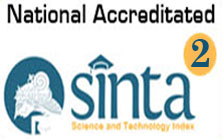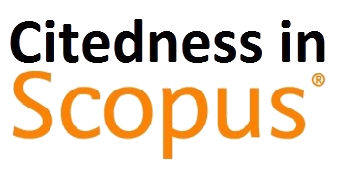Mercury Pollution from Ilegal Gold Mining Activities and Its Impact on Human Health in the Anahoni River, Kaiely Bay, Maluku: A Review
DOI:
https://doi.org/10.31965/infokes.Vol22.Iss1.1548Keywords:
Anahoni River, Mercury Pollution, Environmental ConsequenceAbstract
Illegal gold mining in the Anahoni River area, Kaiely Bay, Maluku, intensifies mercury pollution, posing grave environmental and health risks. Statistical analyses reveal a significant correlation between illegal mining and escalating mercury levels, necessitating urgent intervention. Environmental impacts include biomagnification in fish, affecting indigenous communities dependent on these resources. Health risks encompass neurological, reproductive, and respiratory implications, warranting targeted public health interventions. Examining the broader context, the global dimension of mercury pollution underscores the interconnected nature of the issue, requiring collaborative efforts. The toxicological aspects of mercury and its biogeochemical cycling inform potential mitigation strategies. Methodologically, systematic literature reviews, field investigations, and socio-economic assessments provide a holistic understanding of mercury contamination. Results highlight alarming mercury concentrations, with significant correlations between mercury levels, deforestation, and fish abundance, emphasizing the need for evidence-based policy decisions. Human health implications are evident through a positive correlation between mercury concentrations in river water and human hair samples, emphasizing the direct link between environmental exposure and health risks. Environmental impacts extend beyond human health, affecting ecosystems and necessitating global collaboration. The study underscores the importance of comprehensive policy frameworks, international collaborations, and community engagement in addressing the socio-economic roots of illegal gold mining. Mitigation strategies encompass regulations, sustainable practices, alternative technologies, and community-based initiatives. This review contributes to a nuanced understanding of mercury pollution in the Anahoni River, providing insights into the interconnected challenges and opportunities for sustainable solutions within a concise framework.
Downloads
References
Ali, M., Hery, S., & Putri, S. A. (2018). Mercury toxicity potential from artisanal and small scale gold mines in Lebong Regency, Bengkulu Province. E3S Web of Conferences, 73, 8–10. https://doi.org/10.1051/e3sconf/20187306002
Budnik, L. T., & Casteleyn, L. (2019). Mercury pollution in modern times and its socio-medical consequences. Science of the Total Environment, 654, 720–734.
Castilhos, Z., Rodrigues-Filho, S., Cesar, R., Rodrigues, A. P., Villas-Bôas, R., de Jesus, I., Lima, M., Faial, K., Miranda, A., & Brabo, E. (2015). Human exposure and risk assessment associated with mercury contamination in artisanal gold mining areas in the Brazilian Amazon. Environmental Science and Pollution Research, 22, 11255–11264.
Chen, B., Li, J. S., Chen, G. Q., Wei, W. D., Yang, Q., Yao, M. T., Shao, J. A., Zhou, M., Xia, X. H., Dong, K. Q., Xia, H. H., & Chen, H. P. (2017). China’s energy-related mercury emissions: Characteristics, impact of trade and mitigation policies. Journal of Cleaner Production, 141, 1259–1266. https://doi.org/10.1016/j.jclepro.2016.09.200
Chen, C. Y., Driscoll, C. T., Eagles-Smith, C. A., Eckley, C. S., Gay, D. A., Hsu-Kim, H., Keane, S. E., Kirk, J. L., Mason, R. P., Obrist, D., Selin, H., Selin, N. E., & Thompson, M. R. (2018). A Critical Time for Mercury Science to Inform Global Policy. Environmental Science and Technology, 52(17), 9556–9561. https://doi.org/10.1021/acs.est.8b02286
Clarkson, T. W., & Magos, L. (2006). The toxicology of mercury and its chemical compounds. Critical Reviews in Toxicology, 36(8), 609–662. https://doi.org/10.1080/10408440600845619
Damayanti, R., Lutfie, M., & Technology, C. (2009). Environmental Impact of Artisanal Gold Mining At Cikangean River in Mulyajaya Village , Garut , West Java. 1–9.
Driscoll, C. T., Mason, R. P., Chan, H. M., Jacob, D. J., & Pirrone, N. (2013). Mercury as a global pollutant: Sources, pathways, and effects. Environmental Science and Technology, 47(10), 4967–4983. https://doi.org/10.1021/ES305071V/ASSET/IMAGES/LARGE/ES-2012-05071V_0004.JPEG
Eisler, R. (2004). Mercury hazards from gold mining to humans, plants, and animals. Reviews of Environmental Contamination and Toxicology, 181, 139–198. https://doi.org/10.1007/0-387-21733-9_4
Giang, A., & Selin, N. E. (2016). Benefits of mercury controls for the United States. Proceedings of the National Academy of Sciences of the United States of America, 113(2), 286–291. https://doi.org/10.1073/pnas.1514395113
Gibb, H., & O’Leary, K. G. (2014). Mercury Exposure and Health Impacts among Individuals in the Artisanal and Small-Scale Gold Mining Community: A Comprehensive Review. Environmental Health Perspectives, 122(7), 667. https://doi.org/10.1289/EHP.1307864
Hindersah, R., Kalay, A. M., Risamasu, R., & Dewi, T. (2020). Arsenic in Gold Mine Tailing and Agricultural Soil in Buru Island of Maluku. Soilrens, 18(1), 10–15. https://doi.org/10.24198/soilrens.v18i1.29046
Hsu-Kim, H., Eckley, C. S., Achá, D., Feng, X., Gilmour, C. C., Jonsson, S., & Mitchell, C. P. J. (2018). Challenges and opportunities for managing aquatic mercury pollution in altered landscapes. Ambio 2018 47:2, 47(2), 141–169. https://doi.org/10.1007/S13280-017-1006-7
Kim, S.-H., Kim, K., Ko, K.-S., Kim, Y., & Lee, K.-S. (2012). Co-contamination of arsenic and fluoride in the groundwater of unconsolidated aquifers under reducing environments. Chemosphere, 87(8), 851–856.
Legg, E. D., Ouboter, P. E., & Wright, M. A. P. (2015). Small-scale gold mining related mercury contamination in the Guianas: a review. Paramaribo: World Wildlife Fund.
Levin, M. B., Bowie, J. V, Ragsdale, S. K., Gawad, A. L., Cooper, L. A., & Sharfstein, J. M. (2021). Enhancing community engagement by schools and programs of public health in the United States. Annual Review of Public Health, 42, 405–421.
Li, P., Feng, X. B., Qiu, G. L., Shang, L. H., & Li, Z. G. (2009). Mercury pollution in Asia: a review of the contaminated sites. Journal of Hazardous Materials, 168(2–3), 591–601. https://doi.org/10.1016/J.JHAZMAT.2009.03.031
Lumowa, R., Utomo, S. W., Soesilo, T. E. B., & Hariyadi, H. (2022). Promote Social Order to Achieve Social and Ecological Justice for Communities to Prevent Illegal Artisanal Small-Scale Gold Mining. Sustainability (Switzerland), 14(15). https://doi.org/10.3390/su14159530
Male, Y. T., & Sahuburua, L. F. (2021). Analysis of mercury (Hg) levels in the Patipulu River ecosystem, Kaiely Village, Buru Island. AIP Conference Proceedings, 2360(September). https://doi.org/10.1063/5.0059520
Malm, O. (1998). Gold mining as a source of mercury exposure in the Brazilian Amazon. Environmental Research, 77(2), 73–78. https://doi.org/10.1006/ENRS.1998.3828
Mann, M. E. (2009). Do global warming and climate change represent a serious threat to our welfare and environment? Social Philosophy and Policy, 26(2), 193–230.
Manullang, C. Y., Cordova, M. R., Purbonegoro, T., Soamole, A., & Rehalat, I. (2020). Mercury concentrations in Kayeli Bay, Buru Island of Indonesia: The update of possible effect of land-based gold mining. IOP Conference Series: Earth and Environmental Science, 618(1). https://doi.org/10.1088/1755-1315/618/1/012023
Martanto, D., & Nasihuddin, A. A. (2023). Data-Based Policy as a solution to overcome illegal mining of Mount Botak, Buru Regency, Mollucas Province for sustainable development. Proceeding ICMA-SURE, 2(1), 76. https://doi.org/10.20884/2.procicma.2023.2.1.7793
Mason, R. P., & Sheu, G. (2002). Role of the ocean in the global mercury cycle. Global Biogeochemical Cycles, 16(4), 40–41.
Rakib, M. A., Sasaki, J., Matsuda, H., Quraishi, S. B., Mahmud, M. J., Bodrud-Doza, M., Ullah, A. K. M. A., Fatema, K. J., Newaz, M. A., & Bhuiyan, M. A. H. (2020). Groundwater salinization and associated co-contamination risk increase severe drinking water vulnerabilities in the southwestern coast of Bangladesh. Chemosphere, 246, 125646.
Roulet, M., Lucotte, M., Canuel, R., Farella, N., Courcelles, M., Guimaraes, J.-R., Mergler, D., & Amorim, M. (2000). Increase in mercury contamination recorded in lacustrine sediments following deforestation in the central Amazon. Chemical Geology, 165(3–4), 243–266.
Roulet, M., Lucotte, M., Farella, N., Serique, G., Coelho, H., Sousa Passos, C. J., De Jesus da Silva, E., Scavone de Andrade, P., Mergler, D., & Guimarães, J.-R. D. (1999). Effects of recent human colonization on the presence of mercury in Amazonian ecosystems. Water, Air, and Soil Pollution, 112, 297–313.
Salatutin, F. M., Batawi, C. Y., Lessil, C. Y., & Male, Y. T. (2015). Analisis Of Mercury (Hg) Distribution In The Waepo River Irrigation Area, Buru Regency, Maluku Province, Gold Mining Without Permission Result In Botak Mountain Area. J. Chem. Res, 3, 270–276.
Schleicher, N. J., Schäfer, J., Chen, Y., Blanc, G., Chen, Y., Chai, F., Cen, K., & Norra, S. (2016). Atmospheric particulate mercury in the megacity Beijing: Efficiency of mitigation measures and assessment of health effects. Atmospheric Environment, 124, 396–403. https://doi.org/10.1016/j.atmosenv.2015.09.040
Selin, N. E. (2009). Global biogeochemical cycling of mercury: A review. Annual Review of Environment and Resources, 34, 43–63. https://doi.org/10.1146/ANNUREV.ENVIRON.051308.084314
Sharma, B. M., Bharat, G. K., Šebková, K., & Scheringer, M. (2019). Implementation of the Minamata Convention to manage mercury pollution in India: challenges and opportunities. Environmental Sciences Europe, 31(1). https://doi.org/10.1186/s12302-019-0280-3
Streets, D. G., Zhang, Q., & Wu, Y. (2009). Projections of global mercury emissions in 2050. Environmental Science & Technology, 43(8), 2983–2988.
Tuaputy, U. S., Kumala Putri, E. I., & Anna, Z. (2014). Eksternalitas Pertambangan Emas Rakyat di Kabupaten Buru Maluku. Journal of Agriculture, Resource and Environmental Economics, 1(1), 71–86. https://doi.org/10.29244/jaree.v1i1.11301
UNEP, U. (2013). Global mercury assessment 2013: sources, emissions, releases and environmental transport. In UNEP Chemicals Branch, Geneva, Switzerland.
Downloads
Published
How to Cite
Issue
Section
License
Copyright (c) 2024 JURNAL INFO KESEHATAN

This work is licensed under a Creative Commons Attribution-NonCommercial-ShareAlike 4.0 International License.
Copyright notice
Ownership of copyright
The copyright in this website and the material on this website (including without limitation the text, computer code, artwork, photographs, images, music, audio material, video material and audio-visual material on this website) is owned by JURNAL INFO KESEHATAN and its licensors.
Copyright license
JURNAL INFO KESEHATAN grants to you a worldwide non-exclusive royalty-free revocable license to:
- view this website and the material on this website on a computer or mobile device via a web browser;
- copy and store this website and the material on this website in your web browser cache memory; and
- print pages from this website for your use.
- All articles published by JURNAL INFO KESEHATAN are licensed under the Creative Commons Attribution 4.0 International License. This permits anyone to copy, redistribute, remix, transmit and adapt the work provided the original work and source is appropriately cited.
JURNAL INFO KESEHATAN does not grant you any other rights in relation to this website or the material on this website. In other words, all other rights are reserved.
For the avoidance of doubt, you must not adapt, edit, change, transform, publish, republish, distribute, redistribute, broadcast, rebroadcast or show or play in public this website or the material on this website (in any form or media) without appropriately and conspicuously citing the original work and source or JURNAL INFO KESEHATAN prior written permission.
Permissions
You may request permission to use the copyright materials on this website by writing to jurnalinfokesehatan@gmail.com.
Enforcement of copyright
JURNAL INFO KESEHATAN takes the protection of its copyright very seriously.
If JURNAL INFO KESEHATAN discovers that you have used its copyright materials in contravention of the license above, JURNAL INFO KESEHATAN may bring legal proceedings against you seeking monetary damages and an injunction to stop you using those materials. You could also be ordered to pay legal costs.
If you become aware of any use of JURNAL INFO KESEHATAN copyright materials that contravenes or may contravene the license above, please report this by email to jurnalinfokesehatan@gmail.com
Infringing material
If you become aware of any material on the website that you believe infringes your or any other person's copyright, please report this by email to jurnalinfokesehatan@gmail.com.


















